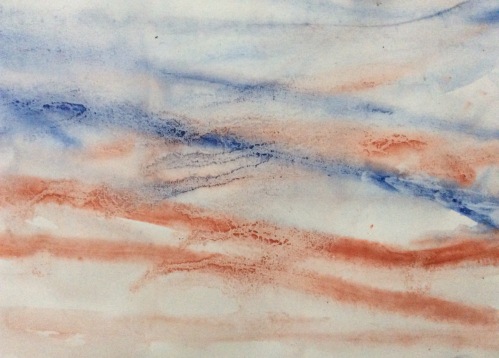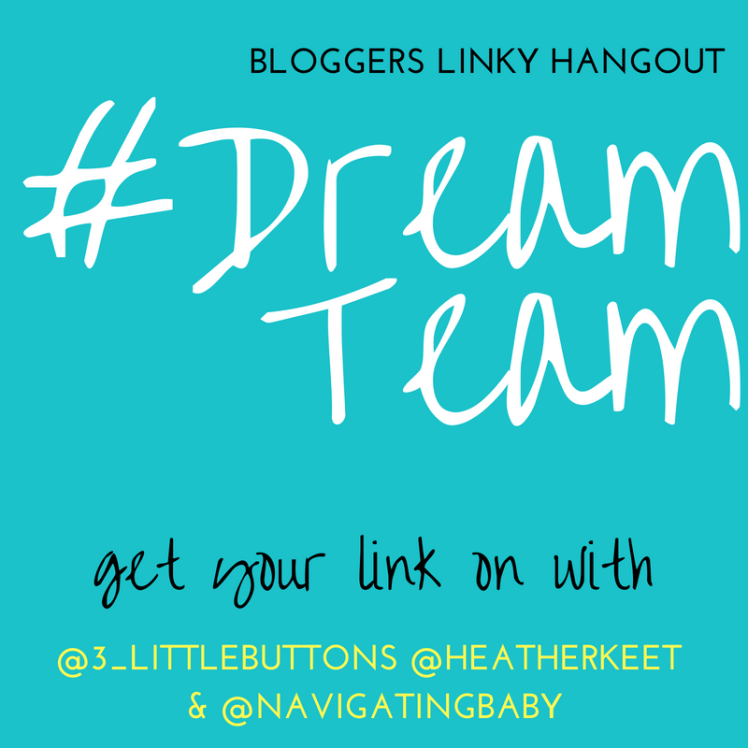We did some wet-on-wet painting yesterday, and it made me think about the things I really like about it. I especially appreciate how it tends to give great results despite being so simple. Or maybe it’s BECAUSE it’s so simple that the results are great..?
Either way, I thought it could be worthwhile sharing with you how we usually go about painting wet-on-wet, as well as a few examples of our results, and some thoughts on the positives of using this technique.

What materials are needed for wet-on-wet watercolours?
I’d say the minimum requirements are:
- Paper, thick and sturdy enough to use for watercolours
- Watercolour paints
- A sponge or two
- At least one brush, preferably wide (around 3/4” or so is great)
We usually use a heavy cartridge paper, sponge it down with water, and then apply watercolours using a fairly wide brush. Most of the time we choose just two or maybe three colours to use, and you can actually do a lot with only one colour as well, focusing on effects created by differences in intensity (light/dark), different brush strokes, and shapes.

Sometimes we’ve skipped the brush and just used sponges for applying the colours as well, and other times we’ve made it more of a gross motor activity, using the garden hose to wet the papers and then splattered and/or dripped the paint from above.

In what ways could this be considered “a mindful sensory art experience”?
In all fairness, pretty much all art activites are more or less of a sensory experience, and when painting, we’ll naturally be using our visual sense in particular, focusing on colours, lines and shapes. When painting wet-on-wet, the soaking of the paper with a squishy sponge, and the overall wetness of the whole activity, brings almong an element of ‘messy play’. Of course there are many other ways of including tactile aspects of various kinds in painting activities, wet-on-wet watercolours is just one possibility.
Moving on to the ‘mindfulness’ of painting wet-on-wet, I will start off by saying that I’m not in any way a pro when it comes to mindfulness, nor am I a qualified art therapist or trained in the Waldorf methods of painting which I will talk a little bit about below. But I’m hoping that our experiences and my reflections on these can still be of use and inspiration! If this sparks an interest, there is a whole world of further knowledge which you can go on to seek out in your own time, if you so wish.
Firstly, some background: When our Penguin was little, he went to a Waldorf preschool (or rather he went to two different ones, due to us moving when he was 3 years old), and after that he attended a Waldorf school for about 1.5 years, before we decided on giving home education a go instead. We’re quite eclectic in our approach to learning, so I’m happy to take on board influences from various educational philosophies, and although our overall experience of the Waldorf school that Penguin attended wasn’t a very positive one (to put it nicely), I can still take inspiration from some of their methods and ideas.

Although I’d experimented a little bit with wet-on-wet painting myself when I was younger, I got a whole new perspective on it when taking part in the lessons at Penguin’s school. There, the activity was almost ceremonial, and meditative. They used large,thick papers of perfect quality for this purpose, and these were soaked in water well in advance, in shallow trays. When it was time to paint, each child collected a painting board to put the paper on, and then when the paper was placed on the board they carefully brushed it with a sponge to make sure no air bubbles were trapped under the paper. The children were also provided with a small glass cup containing liquid watercolours. When everyone was ready to start painting, they each grabbed their brush, and from that moment total silence was expected (and often achieved, too!).
The focus was very much on the experience of the colour being applied to the wet paper, as well as the physical act of it all, holding the brush, dipping it into the paint (they used liquid watercolours), moving it across the paper while applying the colour, and so on.

This is where the mindful side to this activity becomes apparent. As I said earlier, I’m not at all an experienced mindfulness practitioner, but I know that a fundamental part of it is about focusing mentally on being in the now, and taking detailed notice of both our inner and outer world at the present moment.
As I see it, painting wet-on-wet in the way they did it at Penguin’s school, and in the ways we tend to do it at home now, really encourages a moment of being mindful. To take full advantage of this, I’d recommend:
- Staying abstract, rather than being figurative. Let the colours and shapes be enough in themselves.
- Using a limited amount of colours, preferably just one or two. I think it helps keeping focus on the act of painting, not having to consider colour choices during the activity.
- Having an idea about form before you get started. For example, just painting horisontal lines across the paper, from left to right. Perhaps with an intention of gradually making the colour lighter at the bottom and gradually darker towards the top? Or start off by making some kind of shape in the middle, perhaps a spiral for example, and then just build on that, perhaps including a second colour and letting the two meet..?
Before letting you run off to get your paints out, I want to confess that our painting sessions probably never appear very ‘mindful’ to any onlookers. Penguin is, for the most part, a very full on kind of person, and he’ll rarely stop moving about for more than a brief moment. However, in some ways I think he could be described as a very ‘mindful’ person, as his natural setting is to live very much in the moment, always taking notice of details in his surroundings and communicating with his whole body rather than with words (for those of you who don’t already know, he’s autistic and non-verbal).
Either way, I feel that this type of painting activity provides us with opportunities to focus on and enjoy the qualities of the materials and colours, in a simple and low-demand kind of way. And if I feel that we’re not having a great day, for example if Penguin is a bit ‘all over the place’, this usually helps us finding a somewhat calmer and more positive mindset. I hope some of you can relate!

Thank you so much for reading! For more art & crafts ideas from us, please take a look HERE. And to see more of what else we get up to, join us on social media!:
-
- Facebook: facebook.com/sensationallearninguk
- Instagram: instagram.com/sensationallearningwithpenguin
- Pinterest: pinterest.com/senlearnuk
- Twitter: twitter.com/senlearnuk
*******
Linking up with:




Fantastic – looks like you’ve had LOADS of fun with this x
LikeLiked by 1 person
Thank you! Pretty much anything that involves water is great fun in our books 😄xx
LikeLiked by 1 person
That looks like so much fun! I think we’ll have to give it a try! #MMBC
LikeLiked by 1 person
Thank you Kim! I hope you have great fun making penguins together! xx
LikeLike
The results are so pretty. I’d so like to have a go at doing some watercolour painting like this, I wonder if I’d be able to keep my three quiet and focused while doing it?
#mmbc
LikeLiked by 1 person
Thank you! Let’s hope you can have a relatively peaceful time painting together! And if not, perhaps painting on your own (if you ever get a minute to yourself 😬) could be a great way to unwind xx
LikeLike
I wish I had the time to do more arts and crafts with Olivia – she would love this sensory play! 🙂 #KCACOLS
Sarah
LikeLiked by 1 person
I hope you get a chance to do some painting together. It’s usually fairly quick and not too much clean up etc, so if you can find 15-20 mins that could be more than enough xx
LikeLiked by 1 person
This looks like fun. It reminds me of some marbling I used to do. You put the paint on water, swirl it around and then dip the paper in it to pick up the paint. I used to make note cards with it.
LikeLiked by 1 person
Marbling is great! My dad used to do book-binding as a hobby, and made lots of beautiful marbled papers for his book covers etc. I loved it when I too got to try that.
The materals I’ve tried marbling with since then hasn’t given quite the same results, but still beautiful and quite a magical process xx
LikeLike
Thank looks so fun and the paintings are beautiful. I’ve always been fascinated by Steiner approach but there’s no where near us that follows it so J just goes to ‘standard eyfs’ Preschool/nursery x
LikeLiked by 1 person
Thank you! Yes, I think there are a lot of good things about the Steiner/Waldorf approach, so I like to take inspiration from them. The downside with Steiner schools can be that some of the staff is so invested in the purist ’Steiner ways’ of doing things, that there can be a lack of flexibility, and a tendency to blame the parents or children if something isn’t working well (because Steiner’s ideas can’t be questioned). Not all staff is as inflexible as some, so I don’t want to paint Waldorf schools in a negative light, just that there is good and bad. Xx
LikeLiked by 1 person
This will be perfect for my eldest. I will let you know how we get on when we get round to doing it xx
LikeLiked by 1 person
Thank you Jade, I hope you both really enjoy it! xx
LikeLiked by 1 person
This looks like so much fun. And the paintings really did turn out beautiful. #KCACOLS
LikeLiked by 1 person
Thank you so much lovely! 💖
LikeLiked by 1 person
This is a great activity for getting the kids using their motor skills and sensory input too. I love it and the results are lovely! Thanks for linking to #kcacols and hope to see you again next time.
LikeLiked by 1 person
I’m delighted to hear you like it, thank you! x
LikeLike
I love the look of this activity! You really do get up to some lovely things together, I love seeing all your creative ideas. #KCACOLS
LikeLiked by 1 person
Thank you so much, Rachel! You’re pretty creative yourself 😉 xx
LikeLike
What a lovely activity and the paintings look fab! We will have to give this a go! x #MMBC
LikeLiked by 1 person
Thank you! I hope you’ll enjoy it! x
LikeLike
Love the yellow and blue ones, they remind me of my fave place, the beach!
LikeLiked by 1 person
We too love the beach 💕x
LikeLike
Looks lovely and relaxing. I always enjoy doing things with.hands calms me down X #kcacols #mmbc
LikeLiked by 1 person
Thank you Sam! Yes, I to find using my hands calming. As long as it’s nothing too complicated! I’m not great at things like knitting for example, it takes too much concentration for me x
LikeLike
Oh my toddler would love this and I really like having random stuff he paints professionally framed. This would lend itself to that! #kidsandkreativity
LikeLiked by 1 person
I love that you frame some of his artwork! Kids’ paintings can really look great when framed and hung up on the wall xx
LikeLike
This sounds like a lovely activity and the results look great too. Thanks for sharing with the #DreamTeam
LikeLiked by 1 person
Thank you Kirsty! xx
LikeLike
This looks like great fun. I will need to dig out the watercolours and give it a go with my girls. #kidsandkreativity
LikeLiked by 1 person
Thank you Jan! I hope that you’ll all have a lovely time painting together! x
LikeLike
What a great idea, it’s a process art with great results! I remember doing similar in art classes as a kid myself, hadn’t thought about doing it with my two so thanks for the idea! Thanks for linking up with #KidsandKreativity, really hope you join me again next time x
LikeLiked by 1 person
Thank you Kerry! Yes, it’s a pretty simple and enjoyable process, and the results are often very pleasing! We often use them as ’covers’ for little books/flyers we make about animals etc, but they could also be nice to fold little boxes out of (I’m going all in waldorf there ;-)) xx
LikeLike
From some who studied art to degree level I can completely believe the meditative qualities of this activity. Just focusing on the brush and each brush stroke and taking your time to watch the colour ‘bleed’ before you make your next mark! Very relaxing and soothing. #KidsandKreativity
LikeLiked by 1 person
Yes absolutely, you describe it really well! I only did a BTEC foundation diploma in Art & Designs (once upon a very long ago…). I had plans of doing a photography degree, but ended up going down a different route in life at that point. Later took an MA majoring in Art History instead, which was also interesting and fun 🙂 xx
LikeLike
I’ve never heard of wet-on.wet painting but it looks really fun. It looks like a really calming and relaxing experience :o)
#MMBC
LikeLiked by 1 person
Thank you Catherine, you should try it! xx
LikeLike